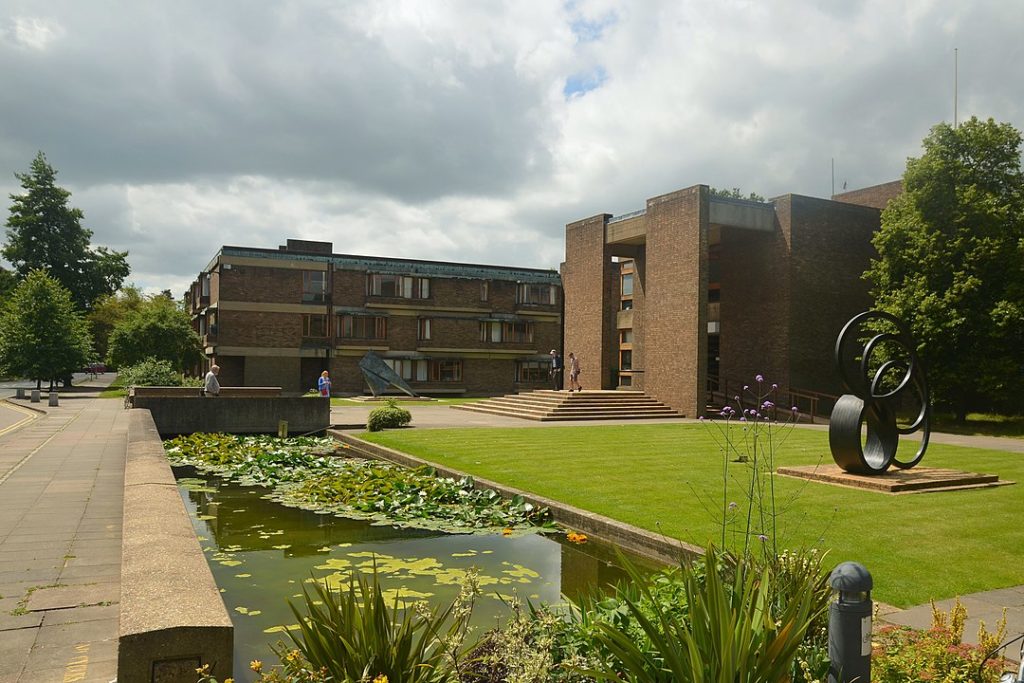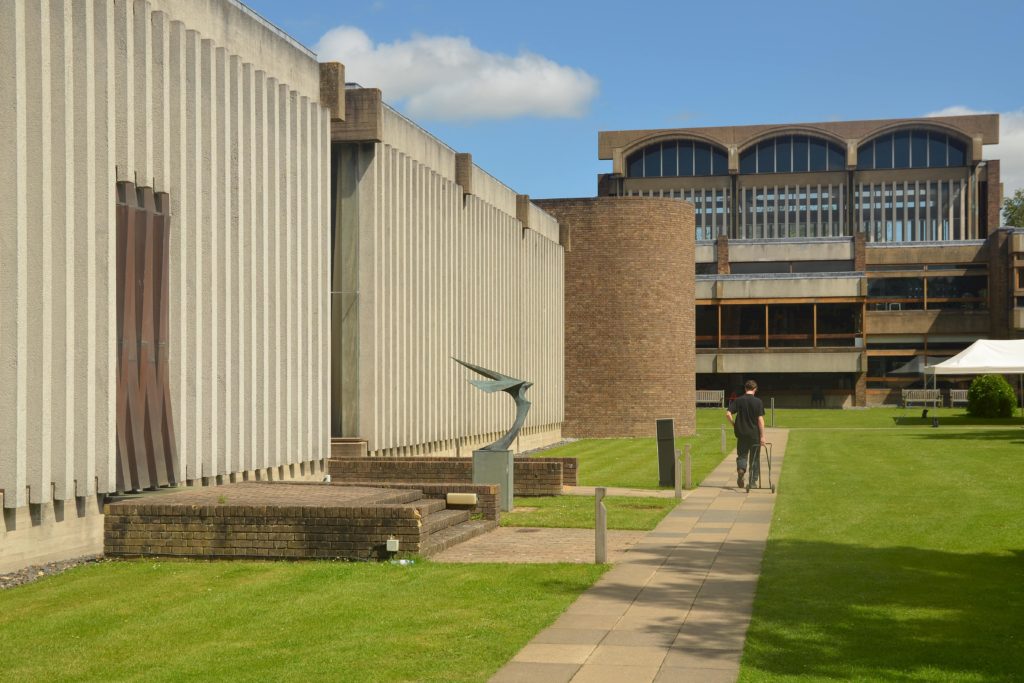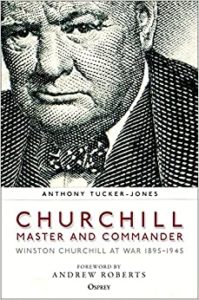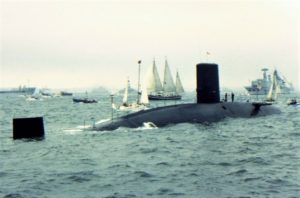
Finest Hour 195
“The Imagination and Power to Develop”
The Foundation of Churchill College

Main entrance to Churchill College, Cambridge
October 21, 2022
Finest Hour 195, First Quarter 2022
Page 40
By Allen Packwood
Allen Packwood OBE is Director of the Churchill Archives Centre and a member of the Operating Committee of the International Churchill Society.
On 17 October 1959, Sir Winston Churchill travelled to Cambridge to perform a symbolic tree planting ceremony at the site for the new College that was to bear his name. Nothing had yet been built, but that did not stop him from articulating his dream for the institution. He was just short of his eighty-fifth birthday and this was to be one of his last public engagements, but his focus was very much on the future. The moment was captured in a rare piece of 16mm colour film footage taken by Churchill’s former Private Secretary Jock Colville. There is no mistaking Churchill’s vigour with the spade. An audio recording of his remarks also survives along with his speech notes. Speaking of his hopes for his College, Churchill said:
In quality, we should endeavour to outstrip our friends and our rivals as we have done in the past. Let no-one believe that the lunar rockets, of which we read in the press, are merely ingenious bids for prestige. They are manifestations of a formidable advance in technology. As with many vehicles of pure research, their immediate uses may not be apparent. But I do not doubt that they will ultimately reap a rich harvest for those who have the imagination and power to develop them, and to probe ever more deeply into the mysteries of the universe in which we live.1
A year later, in 1960, the College admitted its first twentyfive advanced or postgraduate students. By 1964 it was home to 245 undergraduates, 100 advanced students, and sixty-two Fellows. Today, it houses almost 500 undergraduates, nearly 400 postgraduates, and has an academic body of more than 250 Fellows. The College receives students in all subjects but, in accordance with its founder’s wishes, the statutes dictate that two-thirds of the Fellows and students at any one time must be engaged in scientific and technological study and research.

2025 International Churchill Conference
Antecedents
All this we owe to the rain in Sicily! For the origins of the College can be traced back to April 1955. Churchill had just stepped down from his peacetime premiership. This time he knew that age and ill health had finally caught up with him, and that his departure from 10 Downing Street marked the end of his long and colourful public life. As always, he sought solace in painting and warmer climes, travelling with a small retinue for a holiday in Sicily. The rain meant that he could not spend as much time as he liked on his canvases, and provided his friend and scientific adviser Lord Cherwell (the former Oxford physicist Frederick Lindemann, see story on p. 14) with plenty of opportunity to air one of his favourite topics—the fact that Britain was not doing enough to train future generations of scientists and technologists. When Churchill expressed the regret that he had not been able to do more while in office, he was told that it was not yet too late. His former Private Secretary Sir Jock Colville offered to act as the fundraiser for this new venture.2
It was a concept designed to appeal to Churchill. For, whilst he was never a scientist, he was always passionately interested in the potential of science and technology. He took flying lessons as a young man, wrote about developments in nuclear physics, biology, and astronomy in order to supplement his income in the 1930s, and encouraged developments in radar, codebreaking, and weaponry during the Second World War. In the post-war period he had followed the escalating scientific cold war with increasing alarm.
Speaking at the Massachusetts Institute of Technology on 31 March 1949, Churchill had taken as his theme “The Twentieth Century—Its Promise and Its Realization,” contrasting the promise of scientific discoveries with the terrible weapons and wars they had actually delivered. Yet he refused to be too pessimistic, seeing science as the servant of man rather than the other way round and advocating stronger Anglo-American relations within the new United Nations as the best way of securing the benefits of scientific progress and guaranteeing peace. He predicted that the Soviet regime would not be able to sustain its grip on its people forever, and that, while “Science no doubt could if sufficiently perverted exterminate us all….it is not in the power of material forces in any period which the youngest here tonight may take into practical account, to alter the main elements in human nature or restrict the infinite variety of forms in which the soul and the genius of the human race can and will express itself.” His was a message of hope, a statement of belief in the possibility of progress through technological advance, if properly controlled and directed, and he had prefaced these remarks with the observation that “We have suffered in Great Britain by the lack of colleges of University rank in which engineering and the allied subjects are taught.”3

So the idea for Churchill College was born out of a number of different needs: it was motivated by a genuine concern for Britain’s future, a concern that was shared by many in industry, government and academia; it also originated from the need to find new interests for Churchill himself and appropriate ways in which to commemorate him. From the beginning the idea was for a memorial to Sir Winston Churchill, but a living memorial that he would help to create.
Foundation
It was not immediately clear that Churchill’s vision would lead to a College at Cambridge. Other possibilities were considered first: an institution at the University of Birmingham or a new foundation at Cranfield University, which was then known as the College of Aeronautics.4 But in the end, it was decided that Cambridge had the willingness, the cutting-edge research, the name, and the structures to support an institution that would be able to develop close links with industry and to foster postgraduate research. The first Master was chosen. He was Sir John Cockcroft, the “atom smasher,” the eminent Cambridge nuclear physicist who had won the Nobel Prize for his pioneering work on the disintegration of atoms, and who had led Britain’s atomic bomb project at Chalk River in Canada and the subsequent postwar atomic energy programme at Harwell.
An impressive trust was put together to raise the £3.5 million funds required to build and endow the new College. Sir Winston was in the Chair, and the body included key members of his wartime team: Lord Tedder, now Chancellor of Cambridge University, who had commanded air operations in the Middle East; Lord Chandos, who as Oliver Lyttelton had served in senior Cabinet positions; and of course the ever-active Colville. The University and the labour unions were also represented, and the successful appeal reflected both the political consensus of the 1950s and the widespread admiration for Churchill. The money came from private subscriptions in the form of more than two thousand benefactions from a wide range of organisations and individuals. From the United States, the Ford Foundation gave one million dollars, but much funding was raised in Britain. The fact that the College now has a Bracken Library, named for Churchill’s right-wing business friend who left much of his furniture, art collection, and wine stock to the College, alongside a Bevin Library, endowed by the unions in memory of Ernest Bevin, is a testament to the wide base on which the College was built.5
The architect was decided by competition. The winner was Richard Sheppard. The design was traditional, with students living on staircases around courtyards, but the style was unashamedly modern, with industrial use of concrete. Sir John Cockcroft recalled showing Churchill the top twenty competition entries at a Trustees meeting. According to Cockcroft, Churchill sat silently through the discussion. “After the meeting he said sadly to me: ‘I did not wish to be obstructive.’”6 Churchill was probably with Prince Charles in the architectural debate, and Colville certainly felt he would have liked something more neo-classical, but he remained proud to be associated with the enterprise. The former Prime Minister was too ill ever to see the completed buildings, or to attend the formal opening ceremony in June 1964 (performed by HRH Prince Philip), but he lived long enough to become the first Honorary Fellow of Churchill College.
The creation of the new College saw it embroiled in two very political debates. Firstly, there was the question of whether it should admit women alongside men and become the first co-educational Cambridge College. There was considerable lobbying for this from educational and political groups, but Jock Colville minuted to his fellow trustees that the University had already swallowed two revolutionary proposals in respect to the College in accepting a bias towards science and engineering, and a high proportion of postgraduate students. To add women to this mix, in his view, would have the effect of dropping a “hydrogen bomb” in the middle of the University.7 The issue was quietly dropped, and Churchill College became the last all-male College to be founded in Cambridge. In mitigation, I have to report that it also became the first all-male College in the University to vote to admit women, which it did in 1969, the first female students arriving in 1972. Today, the College is fully co-educational and working hard to redress continuing gender imbalances in the sciences.
Then there was the question of religion. This was the early 1960s. Churchill was to be a forward thinking and dynamic scientific community. Should it or should it not have the traditional College chapel? The original Trustees decided not, but the founding Fellows decided otherwise and gave land to a Chapel Trust to create a chapel that was technically at but not of Churchill College. But even this very British compromise did not go uncontested. Francis Crick, the famous molecular biologist and—along with James Watson— the man who unravelled the structure of DNA, resigned his fellowship. He took the point further by sending Churchill a letter arguing with irony that if the College was to have a chapel for the young men’s spiritual needs, it might as well have a brothel for their physical needs, and enclosing the first donation to the “Hetairae” fund.8
Cosmopolitan College
Despite these storms the College has prospered. It has been home to important scientific names, such as Sir Hermann Bondi, Sir John Cockcroft, Sir William Hawthorne, Tony Hewish, and Lord Broers. It has supported writers and social commentators like C. P. Snow, George Steiner, and Lord (Michael) Young, and it continues to educate future generations in accordance with Churchill’s original ideals. Every year some of the best and brightest American students get the opportunity to come to Churchill College thanks to the generosity of the Winston Churchill Foundation in the United States, adding greatly to the educational and social life of the community.
Churchill College is different precisely because it was founded as the National and Commonwealth memorial to Sir Winston. Much of the fabric was given by Commonwealth nations. The wooden panelling and flooring in the main dining hall was a donation from the Canadian Lumbermen’s Association, and other areas are fitted out with woods from all over the globe: Australian Black Bean, Nigerian Mansonia, Ghanaian Afromosia, Singalese Satin Wood, New Zealand Rimu, Indian Teak, and Trinidad and Tobago flooring, so that the very fittings capture the international foundation and aspirations of the College.
The College also houses the Churchill Archives Centre, built in 1973 as the final repository for Sir Winston’s personal papers. The facility has since become home to one of the largest modern research collections in the United Kingdom. Here, in climate-controlled strongrooms, Churchill’s papers sit surrounded by those of his family as well as by those of people who worked with, for, or against him— and by some of those that he inspired. The Centre also houses the archives of scientists and engineers like Rosalind Franklin and Frank Whittle. According to Colville, Churchill joked that he was pleased to have a Cambridge College named for him because it put him alongside the Trinity (Trinity College, Cambridge), but his declining health meant that he never returned to Cambridge to visit the site.9 His aim had been to foster greater engagement with science, education, and research. That remains an ongoing mission for the College, but the fact that it has to date enjoyed a connection with some thirty-two Nobel Prize winners is surely evidence of a good direction of travel.10
Endnotes
1. Churchill Archives Centre (CAC), Churchill Additional Papers, WCHL 6/21 for colour film footage of the occasion taken by Jock Colville; CHUR 5/62/563–573, for speaking notes used by Winston Churchill on occasion of tree planting, 17 October 1959; and https:// soundcloud.com/churchillcollege/sets/ccrf-100-2 for audio recording of Churchill’s speech.
2. John Colville, Footprints in Time (London: Collins, 1976), p. 256.
3. https://winstonchurchill.org/ resources/speeches/1946-1963- elder-statesman/mit-midcentury-convocation/ for the full text of Churchill’s speech at MIT, 31 March 1949. See also CAC, Churchill Papers, CHUR 5/24 for speech drafts and notes.
4. CAC, Churchill Papers, CHUR 2/568–572. These files document the early history of the College Trust and the evolution of the plans for the new college. See also https:// www.chu.cam.ac.uk/about/ history-churchill/origins/’.
5. Colville, Footprints, p. 257.
6. CAC, Cockcroft Papers, CKFT 4/37, Speech at Founders’ Dinner, 26 January 1967.
7. CAC, Churchill Papers, CHUR 2/568B/167–69, Letter from Jock Colville to Sir Winston Churchill, 16 June 1958. Colville seems to have forgotten this letter when writing his book Winston Churchill and His Inner Circle (New York: Wyndham, 1981), where he incorrectly asserts on p. 159 that Churchill College was co-educational from the outset.
8. CAC, Churchill Papers, CHUR 2/571/229–30, Letter from Francis Crick to Sir Winston Churchill, 12 October. 1961.
9. Colville, Footprints, p. 258.
10. See Churchill College website, https://www.chu.cam.ac.uk/about/history-churchill/nobelprize-winners/
Subscribe
WANT MORE?
Get the Churchill Bulletin delivered to your inbox once a month.





